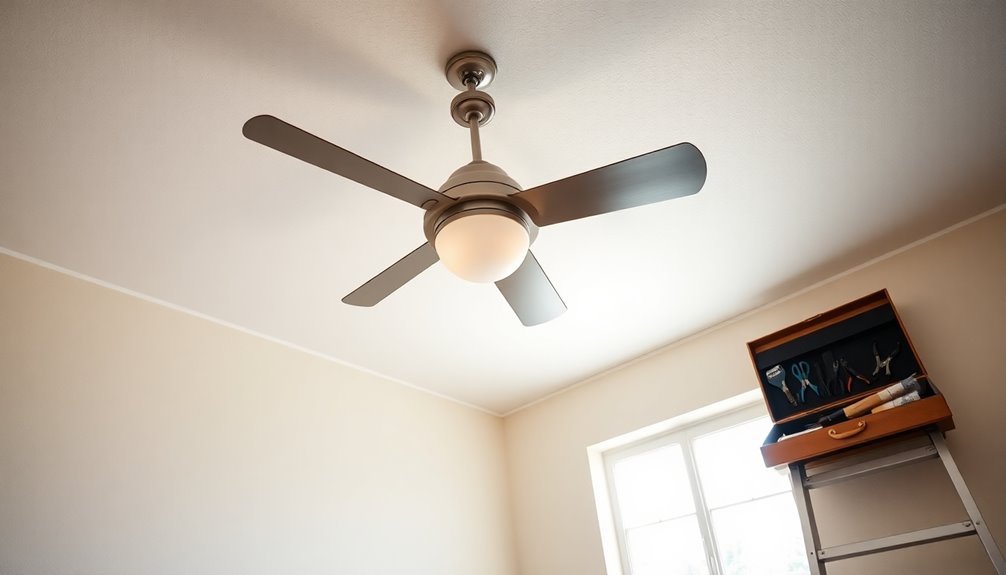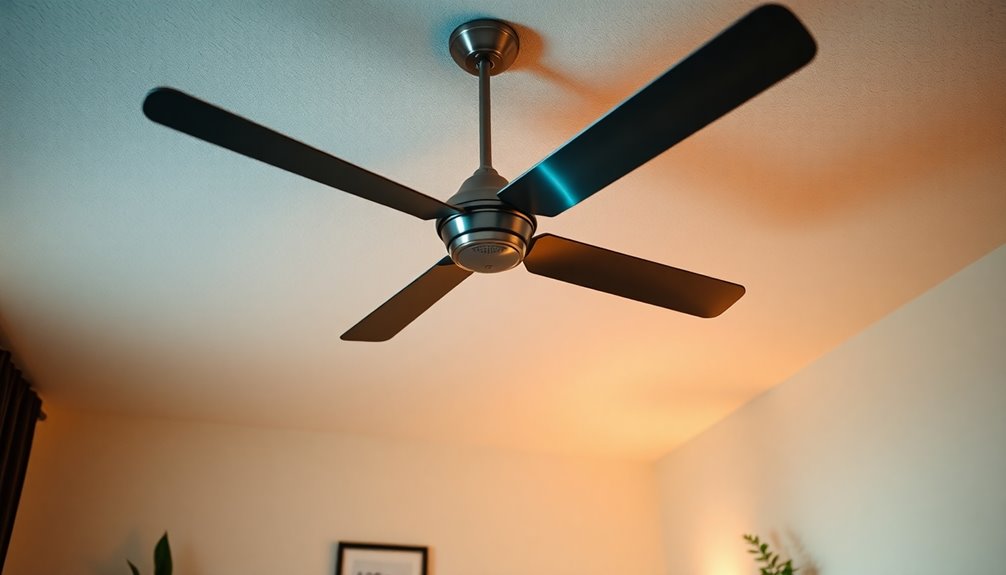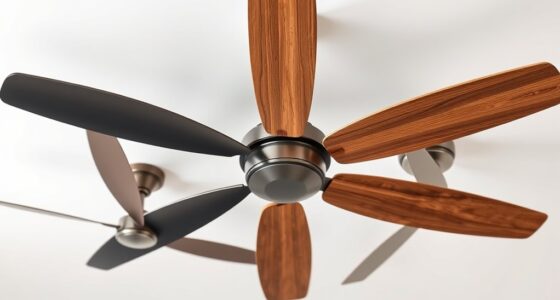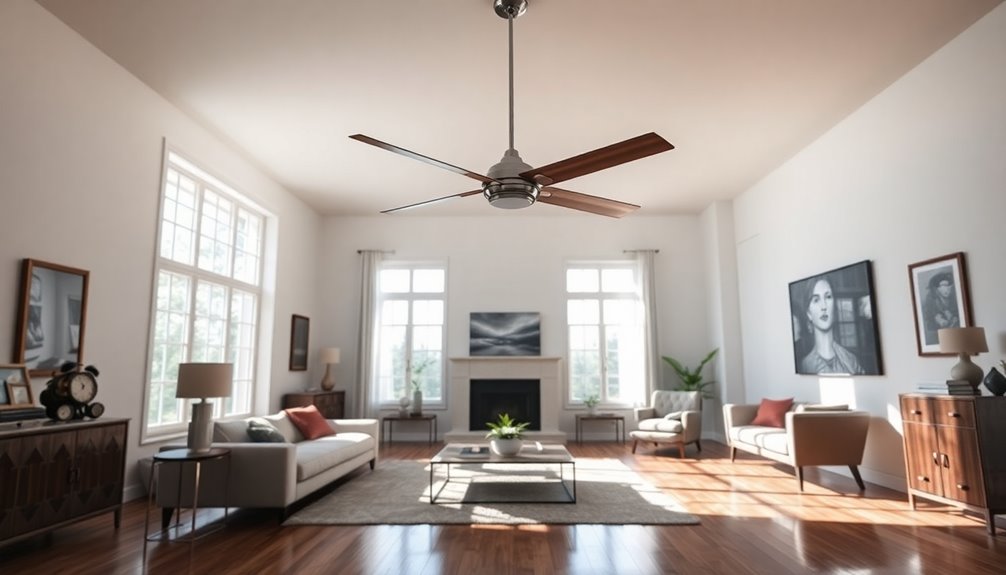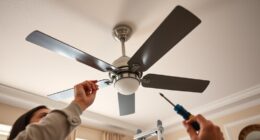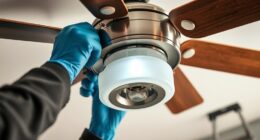You should hire an electrician to install your ceiling fan for safety and efficiency. Improper installation can lead to electrical hazards, including fires and shocks. A professional guarantees that everything is wired correctly, meeting safety standards and complying with electrical codes. They can also handle unexpected wiring issues that might arise. While DIY projects might seem appealing, they can lead to costly repairs if mistakes are made. In the long run, hiring an electrician not only mitigates risks but can also save you money on energy bills. Keep exploring to uncover more benefits of professional installation!
Key Takeaways
- Hiring a licensed electrician ensures safe installation, reducing the risk of electrical hazards and compliance with local codes.
- Professional installation prevents costly mistakes from DIY errors, which can lead to expensive repairs down the line.
- Electricians possess the expertise to handle complex wiring issues that may arise during installation.
- Ceiling fans can be heavy; an electrician ensures proper mounting and stability to avoid accidents.
- If there's no existing wiring or you're inexperienced with electrical systems, it's best to call a professional.
Benefits of Ceiling Fans

Ceiling fans offer a range of benefits that can enhance your home's comfort and efficiency. They greatly lower energy costs by allowing you to set your thermostat higher while still feeling cool thanks to improved air circulation. This wind chill effect reduces your reliance on air conditioning, which helps extend its lifespan and cuts down on maintenance needs.
In addition to saving money, ceiling fans also improve indoor air quality. By promoting ventilation and effectively dispersing pollutants, they create a healthier living environment.
Plus, with various styles and designs available, ceiling fans can serve as both functional appliances and attractive décor elements that elevate the aesthetic appeal of any room.
Many ceiling fans are designed for year-round use, featuring reverse settings that allow warm air to circulate during winter. This can further reduce your heating needs in milder climates.
Incorporating ceiling fans in your home can complement other energy-efficient systems, such as heat pumps that provide sustainable heating and cooling solutions.
Whether you're looking to enhance comfort, improve air quality, or save on energy costs, ceiling fans are a smart investment. If you're unsure about installation, consider hiring a professional to guarantee everything's set up correctly for peak performance.
Risks of DIY Installation

When you tackle a DIY ceiling fan installation, you face serious risks, especially with wiring.
Incorrect connections can lead to dangerous electrical hazards, while using ladders without proper safety measures increases your chances of falls.
It's essential to weigh these risks against the potential benefits before deciding to go it alone.
Wiring Safety Hazards
Installing a ceiling fan on your own can seem like a straightforward task, but it carries significant wiring safety hazards. If you're not careful, you could face serious issues that compromise both your safety and your home.
Here are three critical risks to contemplate:
- Electrical Fires: Incorrect wiring can lead to circuit failures, resulting in electrical fires or damage to your fan and home wiring.
- Electric Shocks: Handling live wires without proper knowledge increases the risk of serious electrical shocks or even electrocution.
- Improper Installation: Using the wrong ceiling box can cause the fan to be unstable, potentially leading to it falling and causing injury or damage.
Many homes have outdated wiring that may not meet current electric code requirements, making it vital to evaluate your system before proceeding.
In this situation, you might realize that you really need an electrician to guarantee a safe installation.
Avoid the risks associated with DIY ceiling fan installations, as the potential hazards far outweigh the benefits.
Don't take chances; prioritize your safety and the integrity of your home by seeking professional help.
Fall Risk Factors
While wiring safety hazards are a top concern, fall risk factors during DIY ceiling fan installation shouldn't be overlooked.
Using a ladder to reach high ceilings increases your chances of accidents, especially if you don't take proper safety precautions. Improper ladder placement or failing to secure the ladder can lead to serious injuries. If your ceiling is particularly high, balancing while working above ground becomes even trickier, raising the risk of losing your footing.
Additionally, dropping tools or equipment during installation can't only injure you but also pose a risk to anyone nearby. Falls from ladders are among the most common causes of home injuries, highlighting the need for caution.
Considering these fall risk factors, it might be wise to hire an electrician for your ceiling fan installation. Professionals are trained to handle the complexities of working at heights and know how to position ladders safely.
Importance of Hiring an Electrician

Hiring an electrician for your ceiling fan installation isn't just a good idea; it's essential for guaranteeing safety and compliance with electrical standards. When you choose to hire a professional, you're not only investing in proper installation but also reducing potential risks.
Here are three key reasons to reflect on:
- Compliance: Electricians guarantee your installation meets the National Electric Code, minimizing legal risks associated with improper setups.
- Expertise and Tools: With specialized training and tools, electricians can efficiently handle the installation, implementing necessary safety measures to reduce hazards.
- Problem-Solving: Professionals can quickly identify and resolve any unforeseen issues, guaranteeing your ceiling fan operates correctly and safely from the start.
While the average cost of hiring an electrician ranges from $100 to $300, this investment can save you from costly repairs due to DIY mistakes.
Additionally, proper installation by an electrician not only enhances safety but also leads to long-term energy savings, markedly lowering the risk of electrical fires or shocks.
In the end, hiring an electrician is a wise choice for your ceiling fan installation.
Choosing the Right Electrician

Finding the right electrician for your ceiling fan installation is vital to ensuring a successful and safe setup. Start by confirming that the electrician holds a valid state license and relevant certifications. This guarantees compliance with local regulations, protecting you and your home.
It's also important to verify the electrician's experience, specifically with ceiling fan installations, as they can present unique challenges.
Don't overlook the importance of liability insurance; this protects you from any accidents or damages during the installation process. A reputable electrician will readily provide proof of this coverage.
To find the right electrician, check online reviews, testimonials, and ask friends or family for recommendations. A positive reputation often indicates quality service, so do your research.
Finally, request a detailed estimate that outlines all costs involved, including labor and materials. This transparency helps prevent unexpected charges later on. Additionally, consider their approach to safety compliance, as following regulations can greatly reduce the risk of electrical hazards.
Cost Considerations

When considering the installation of a ceiling fan, understanding the cost factors involved is key. Here are three major cost considerations to keep in mind:
- Labor Costs: Hiring an electrician to install your ceiling fan typically ranges from $100 to $300, depending on the complexity of the job and your location. An experienced electrician can also ensure the fan's installation aligns with safety regulations, reducing the risk of electrical hazards.
- DIY Expenses: While you might think installing a ceiling fan yourself can save money, any mistakes could lead to expensive repairs later. If you don't have the right tools, you'll need to buy or rent equipment, which adds to the cost. Additionally, improper installation can lead to issues such as airflow problems, reducing the fan's efficiency.
- Long-Term Savings: An efficiently installed ceiling fan can reduce your reliance on HVAC systems, leading to lower energy bills that offset those initial installation costs. Additionally, proper installation techniques can enhance the fan's performance and lifespan. Installing energy-efficient systems, such as commercial grade heat pumps, can also contribute to significant energy savings in your home, especially since heat pumps can reduce energy consumption by up to 50%. Investing in a professional electrician to install your ceiling fan can prevent costly future repairs associated with improper wiring or installation errors.
It's important to weigh these cost considerations carefully, as they can greatly impact your home's safety and comfort.
Ultimately, the choice between DIY and hiring a professional should consider both immediate expenses and long-term benefits.
Installation Process Overview

When installing a ceiling fan, you'll start with an initial assessment of the wiring and ceiling structure to guarantee everything's safe and compatible.
Next, you'll secure the mounting bracket and connect the electrical wires according to the instructions.
Finally, you'll test the fan's functionality to make certain it operates correctly and meets safety standards. Additionally, it's important to ensure that the fan is designed for optimal air circulation to enhance comfort and efficiency in your space.
Initial Wiring Assessment
An initial wiring assessment is essential before you install a ceiling fan, as it helps determine whether your existing electrical setup can safely support the fan.
Here are three key aspects to check during the assessment:
- Ceiling Box: Confirm your ceiling box is properly rated to support the weight and movement of the ceiling fan. Standard light fixture boxes often can't handle the load.
- Proper Grounding: Verify that your wiring includes proper grounding. This safety measure prevents electrical shocks and confirms the fan operates efficiently.
- Electrical Codes: Confirm that your wiring meets current electrical codes. You might need to upgrade or replace outdated wiring to avoid safety hazards.
If you find any issues during your initial wiring assessment, like inadequate support or faulty wiring, it's best to hire a professional electrician.
They can guarantee a safe and compliant installation, giving you peace of mind while enjoying your new ceiling fan. Additionally, using a professional electrician ensures that all safety measures are adhered to during the installation process.
Mounting and Connections
After confirming your ceiling box is adequately rated and your wiring meets safety standards, you can move on to the mounting and connections of your ceiling fan.
Start by gathering the right tools, including a screwdriver, wire stripper, and ladder. First, secure the fan's mounting bracket to the ceiling box, making sure it's tightly fastened to support the fan's weight during operation.
Next, it's time for electrical connections. Carefully connect the fan's wires to the corresponding wires in your ceiling: black to black, white to white, and green or bare to ground.
Make sure these connections are tight and secure to prevent any electrical issues. It's crucial to follow the manufacturer's instructions closely during this process to guarantee safety and peak performance.
Once you've completed the mounting and connections, you can restore power at the circuit breaker. This step will allow you to check the fan for any wobbling or irregular operation, which might indicate a need for adjustments.
Proper mounting and connections are essential for a safe and efficient ceiling fan installation.
Final Functionality Testing
Final functionality testing is a critical step in confirming your ceiling fan operates as intended. After you've completed the installation, don't forget to restore power at the breaker box. This allows you to test the fan's functionality properly.
Here's what you should focus on during the final testing phase:
- Speed Settings: Check that the ceiling fan operates smoothly at different speed settings. This confirms that the wiring and connections are correct.
- Unusual Noises: Listen for any strange noises during operation. These may indicate improper installation or balance issues that need addressing.
- Reverse Function: If your fan has a reverse function, test it to confirm that it circulates air effectively in both summer and winter modes.
Finally, confirm that all light fixtures connected to the fan are functioning correctly and that there are no flickering issues.
Proper final functionality testing not only guarantees your ceiling fan can help maintain comfort but also gives you peace of mind knowing it's installed correctly. So, take the time to check these details before you settle in and enjoy your newly installed ceiling fan!
Safety Concerns

Installing a ceiling fan without the right electrical knowledge can be a dangerous gamble. You might face serious safety hazards, including electrical shocks and fires from incorrect wiring. Following safety protocols is vital to minimize these risks. Regular maintenance can enhance the efficiency of the refrigeration cycle and ensure safe operation of any electrical appliance.
Here's a quick comparison of potential dangers and solutions:
| Safety Concern | Solution |
|---|---|
| Electrical shocks | Hire a licensed electrician |
| Falls from ladders | Use stable ladders carefully |
| Fan instability | Guarantee proper mounting hardware |
| Improper installations | Follow local safety regulations |
| Legal repercussions | Consult with a professional |
Utilizing the wrong ceiling box or hardware can lead to the fan falling, causing injury or damage. Compliance with national and local safety regulations is critical; improper installations can create legal issues and increase liability for you as a homeowner. Hiring a licensed electrician guarantees that all safety precautions are observed, allowing you to enjoy your new ceiling fan without unnecessary worry. Remember, safety first!
When to Call a Professional

Knowing when to call a professional can save you time, money, and potential hazards when installing a ceiling fan. Here are some key situations where you should definitely consider hiring an electrician:
- No Existing Wiring: If there's no ceiling fixture or wiring in place, an electrician should install it to guarantee safety and compliance. This is particularly important since home security systems often require proper electrical setups to function optimally. Additionally, following local fire safety codes is crucial to ensure a safe installation.
- Heavy or Larger Fans: When you replace a ceiling fan with a larger or heavier model, consult a professional to make certain it's properly supported and meets mounting requirements.
- Wiring Issues: If you encounter unexpected wiring problems, such as outdated or non-compliant wiring, it's best to call an electrician for a safe resolution.
If you're uncomfortable working with electrical systems or lack experience, hiring an electrician is a smart choice to get the job done right. They know local electrical codes and can prevent potential legal issues or safety hazards. Additionally, a professional can ensure that your installation is compatible with the best home security systems, providing enhanced protection for your home.
Frequently Asked Questions
Can You Install a Ceiling Fan Without an Electrician?
Yes, you can install a ceiling fan without an electrician if you have the right skills and tools.
Make sure you've got screwdrivers, wire strippers, and a voltage tester handy. Always turn off the power at the circuit breaker first.
Check that your ceiling box can handle the fan's weight and be mindful of wiring and alignment issues.
If you're unsure about anything, it's best to consult a professional for safety.
Should You Hire an Electrician to Install a Ceiling Fan?
When you're pondering whether to hire an electrician for your ceiling fan, think of it like inviting a skilled artist to your canvas.
You want the installation to be safe and compliant with local codes. An electrician's expertise means they can handle potential issues, ensuring everything runs smoothly.
Plus, investing in their service can save you from costly mistakes down the road.
Can I Install a Ceiling Fan Myself?
Yes, you can install a ceiling fan yourself, but you need to be cautious.
Make certain you understand the electrical system and follow safety precautions to avoid hazards.
Gather essential tools like a ladder, screwdrivers, and a voltage tester.
Check that your ceiling box can support the fan's weight.
If you're unsure about wiring or local codes, consider hiring a professional to guarantee everything's done safely and correctly.
How Much Should It Cost to Have Someone Install a Ceiling Fan?
When it comes to having someone install a ceiling fan, you might say the costs can vary.
Typically, you're looking at about $100 to $300, depending on where you live and how complex the job is.
Keep in mind, if your setup needs some upgrades, that could add to the bill.
Getting a few quotes will help you find the best deal while ensuring a safe, efficient installation.
It's worth the investment!
Conclusion
In the end, while installing a ceiling fan might seem like a breeze, it's often wiser to call in a professional. An electrician can guarantee safety, efficiency, and a hassle-free setup, saving you from potential headaches down the line. Think of them as the guiding light in your home improvement journey. So, when in doubt, don't hesitate to enlist their expertise—your ceiling fan deserves the best, and so do you!
